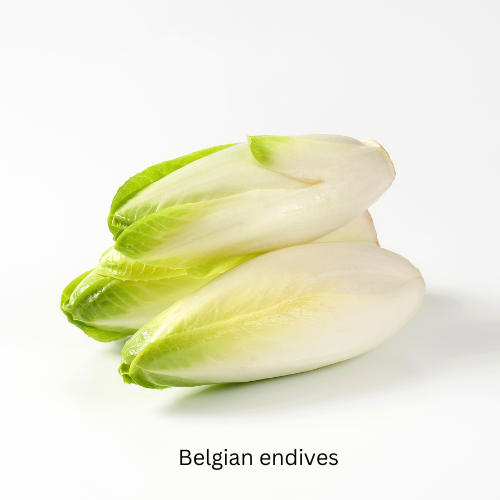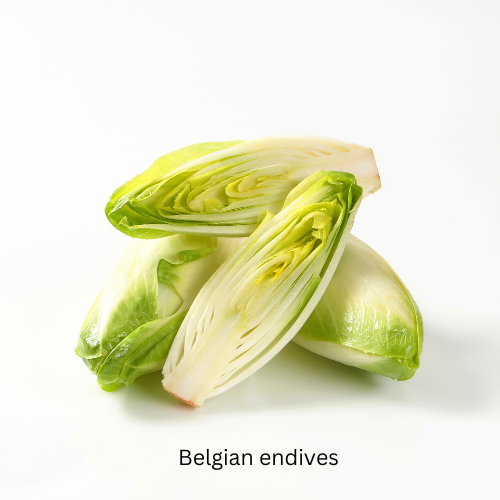



Belgian Endive
Belgian Endive, chicory or witloof, is a leafy vegetable cultivated primarily in the dark to stop the leaves from turning green and opening. Its crisp texture and slightly bitter flavour make it a popular ingredient in salads and dishes.
Here's an overview of Belgian Endive:
Origin and Cultivation: Belgian Endive is a variety of the Chicory plant. It's originally from Belgium, which is where it gets its name. The unique growing process involves two stages: first, the chicory seeds are grown commonly to produce roots, and then the roots are harvested and stored in a dark, cool place to grow the white leaves.
Appearance: It has a distinctive elongated, conical shape with pale yellow and green leaves that are tightly packed. The lack of sunlight during its growth process prevents the leaves from turning green, which is typical for most leafy vegetables.
Taste and Culinary Use: Belgian Endive has a mild, slightly bitter taste. It's often used raw in salads, where its crisp texture can be appreciated. However, it's also versatile in cooking, suitable for grilling, braising, or baking. It pairs well with ingredients that balance bitterness, like nuts, cheese, or sweet dressings.
Nutritional Value: It is low in calories but high in fibre, making it an excellent choice for healthy diets. It also contains vitamins B and C and minerals like potassium and magnesium.
Storage and Preparation: To store Belgian Endive, keep it in a cool, dark place to prevent it from turning green and bitter. Before using, rinse the leaves under cold water and trim the bottom of the bulb.
Varieties and Availability: While the classic Belgian Endive is the most well-known, there are red varieties known as red Endive or radicchio. Belgian Endive is available year-round, with its peak season in the winter months.
Culinary Pairings: Belgian Endive goes well with citrus fruits, blue cheese, walnuts, apples, and vinaigrette dressings. Its crispisp texture and unique flavour make it a sophisticated addition to gourmet dishes.
Nutritional benefits
Belgian Endive, known for its crisp texture and slightly bitter taste, offers several nutritional benefits, rendering it a beneficial component of a nutritious meal.
Here's an overview of its vital nutritional benefits:
Low in Calories: Belgian Endive is very low in calories, making it an ideal choice for weight management or low-calorie diets. It's a good option for adding volume and nutrients to meals without significantly increasing calorie intake.
High in Fiber: This vegetable is a good source of dietary fibre essential for healthy digestion. Fiber helps improve bowel movements, prevents constipation, and may aid in maintaining a healthy weight. It also plays a role in making low cholesterol levels and regulating blood sugar levels.
Rich in Vitamins and Minerals:
Vitamin B: Belgian endives contain several B vitamins, including folate (vitamin B9), which are crucial for DNA synthesis and repair and thus important for pregnant women.
Vitamin C: It provides a large amount of vitamin C, an antioxidant that makes a robust immune system, aids in iron absorption, and helps repair tissues.
Vitamin K: It's an excellent provider of vitamin K, crucial for blood coagulation and maintaining bone health.
Contains Important Minerals:
Potassium is vital for maintaining heart function and regulating blood pressure.
Magnesium: Magnesium contributes to the functioning of muscles and nerves, regulating blood sugar levels and controlling blood pressure.
Antioxidants: Belgian Endive contains antioxidants such as kaempferol and quercetin. These substances can aid in fighting oxidative stress and lowering the likelihood of chronic illnesses like heart disease and cancer.
Low Glycemic Index: Vegetables have a low glycemic index, meaning they cause a slower and smaller rise in blood sugar levels. This makes it suitable for individuals managing diabetes or aiming to keep their blood sugar levels consistent.
Good for Heart Health: The combination of fibre, potassium, and antioxidants in Belgian Endive can contribute to heart health. These nutrients help lower blood pressure and cholesterol, both critical elements in heart health.
Disease prevention.
Supports Healthy Pregnancy: Folate makes Belgian Endive a beneficial food for pregnant women. Folate is essential for fetal development and can help prevent congenital disabilities.
Incorporating Belgian endives into your diet can thus offer various health benefits, especially considering its low-calorie and high-nutrient profile. Its raw and cooked forms versatility, making it an easy and beneficial addition to many dishes.
Top of Form
Bottom of Form
In Ayurveda
In Ayurveda, foods and herbs are chosen based on their properties and the balance they bring to the individual's doshas (the three energies believed to circulate in the body and manage physiological activity). With its unique characteristics, Belgian Endive can also be understood through this lens.
Here's how Belgian Endive might be viewed in Ayurvedic terms:
Taste (Rasa): Belgian Endive is primarily bitter and slightly pungent. In Ayurveda, bitter taste is known to have a cleansing effect on the body, helping detoxify and improve digestion. It's considered beneficial for pacifying Pitta and Kapha doshas but might increase Vata.
Energetics (Virya): The vegetable is likely considered cooling due to its bitter flavour. Cooling foods are generally recommended to balance Pitta dosha, which is associated with heat and fire in the body.
Post-Digestive Effect (Vipaka): Its post-digestive effect could be pungent, which might stimulate the digestive fire (Agni) and help better digestion and assimilation of nutrients.
Effect on Doshas: The bitter and slightly pungent tastes of Belgian Endive can help balance Pitta and Kapha doshas. However, because of its cooling properties and potential to increase Vata, it should be consumed in moderation by individuals with a predominant Vata constitution or those suffering from Vata imbalances.
Health Benefits in Ayurveda:
Digestive Health: Its fibre content and bitter taste can help in digestion and help alleviate digestive disorders like bloating and constipation.
Detoxification: The bitter principle in Belgian Endive is considered suitable for detoxifying the liver and purifying the blood in Ayurvedic practice.
Weight Management: Being low in calories and high in fibre, it's suitable for diets aimed at weight loss, a standard recommendation for managing Kapha imbalance.
Preparation and Consumption: In Ayurveda, the preparation method and combination with other foods are essential. Belgian Endive should be combined with warming spices or foods to balance their cooling properties, especially for those with a Vata or Kapha constitution.
Contraindications: People with a Vata imbalance or those experiencing conditions such as dryness, constipation, or bloating might need to limit their intake of Belgian Endive due to their potential to aggravate these conditions.
It's important to note that Ayurveda emphasizes individualized treatment and dietary recommendations based on a person's constitution, current health condition, and the balance of their doshas. Therefore, the suitability of Belgian Endive may vary from person to person in an Ayurvedic context. Consulting with an Ayurvedic practitioner is recommended for personalized advice and dietary planning.
In Traditional Chinese Medicine (TCM),
In Traditional Chinese Medicine (TCM), foods and herbs are not just sources of nutrition but also tools for balancing the body's energy, or Qi. TCM focuses on food's nature, flavour, and movement to understand its impact on the body's balance. While Belgian Endive is not a traditional ingredient in TCM, we can analyze its properties based on the principles of TCM:
Nature: In TCM, foods are categorized by their thermal nature - warming, cooling, or neutral. Given its crisp texture and slightly bitter taste, Belgian Endive will likely have a cooling character. Cooling foods are used to clear heat and toxins from the body.
Flavour: The primary taste of Belgian Endive is bitter. In TCM, bitter foods are believed to have a drying effect, helping to drain dampness and clear heat. They are often used to strengthen the heart and small intestine.
Organ System Affinities: Bitter foods typically influence the heart and small intestines in TCM. Thus, Belgian Endive may benefit these organ systems, aiding digestion and calming the mind.
Qi and Blood: Belgian endives' bitter flavour and cooling nature suggest they could help move Qi and clear heat from the body. This can be beneficial for conditions related to warmth or Qi stagnation.
Balance and Moderation: In TCM, balance is critical. While Belgian endives' cooling and bitter properties can be beneficial, they should be balanced with other flavours and natures, especially for individuals with a cold constitution or those suffering from conditions characterized by cold and dampness.
Potential Therapeutic Uses: In the context of TCM, Belgian Endive might address issues such as inflammation, heat-related disorders, and digestive problems owing to its cooling and Qi-moving properties.
Cautions: For individuals with a yang deficiency or those experiencing cold and damp conditions, excessive consumption of cooling and bitter foods like Belgian Endive might not be advisable. It's essential in TCM to tailor dietary choices to the individual's constitution and current state of balance.
It's important to note that these interpretations attempt to view Belgian Endive through the lens of TCM principles. Since it is not a traditional food in Chinese medicine, these suggestions are speculative and should be considered as such. In TCM, dietary and herbal recommendations are highly individualized, so it's always best to consult a practitioner for personalized advice.
Preparation
Top of Form
Belgian Endive is a versatile vegetable that can be prepared in various ways, offering a range of flavours and textures. Here are some popular methods to prepare Belgian Endive:
Raw in Salads:
Slice the Endive lengthwise into thin strips or separate the leaves whole.
Combine with apples, walnuts, blue cheese, or citrus fruits.
Dress with a vinaigrette or a light, creamy dressing to balance the bitterness.
Braised:
Cut the endives in half lengthwise.
In a skillet, cut them down with a bit of butter, then add a small amount of chicken or vegetable broth.
Cover and simmer until they are tender and caramelized.
You can add herbs like thyme or bay leaves for extra flavour.
Grilled or Roasted:
Cut the endives in half and brush with olive oil.
Grill or roast at a high temperature until they are tender and have char marks.
Flavour with a small amount of salt, a dash of pepper, and a drizzle of lemon juice or balsamic vinegar.
Stuffed Endive Leaves:
Separate the leaves and use them as a vessel for various fillings.
Fill with mixtures like goat cheese and herbs or a shrimp and avocado salad.
These make great appetizers or light snacks.
Endive Au Gratin:
Parboil whole endives and then wrap them in ham slices.
Please place them in a baking dish and cover them with béchamel sauce and grated cheese.
Cook in the oven until the sauce starts bubbling and the cheese turns golden brown.
Sautéed:
Slice the endives and sauté them in butter or olive oil until they are softened.
Add a white wine or broth splash and cook until the liquid evaporates.
Add some salt, pepper, and a slight amount of sugar to offset the bitterness.
Endive Soup:
Combine chopped Endive with onions, garlic, potatoes, and broth.
Simmer until all ingredients are tender, then blend until smooth.
Season with salt, pepper, and cream for richness if desired.
When preparing Belgian Endive, it's essential to handle it gently to keep the leaves intact. The base of the Endive can be slightly bitter, so trimming a small amount off the bottom before cooking or serving raw can improve the taste. Remember that the bitter flavour of endive pairs well with sweet, acidic, and rich flavours, which can be used to create balanced and flavorful dishes.
Bottom of Form
Recipes
1. Belgian Endive and Apple Salad
Ingredients:
3 Belgian endives, sliced
One apple, thinly sliced
1/2 cup walnuts, toasted
1/4 cup blue cheese, crumbled
Two tablespoons of olive oil
One tablespoon of apple cider vinegar
One teaspoon honey
Salt and pepper to taste
Mixed greens (optional)
Instructions:
In a large bowl, combine the sliced endives and apple.
In a small recipe, combine olive oil, apple cider vinegar, honey, salt, and pepper by whisking them together to prepare the dressing.
Drizzle the sauce over the Endive and apple mixture. Toss gently to coat.
Add the toasted walnuts and crumbled blue cheese.
Serve over a bed of mixed greens if desired.
2. Braised Belgian Endive
Ingredients:
4 Belgian endives halved lengthwise.
Two tablespoons butter
1/2 cup vegetable or chicken broth
Salt and pepper to taste
Fresh thyme or parsley for garnish
Instructions:
Put some in a large skillet over medium heat.
Place the endives cut side down in the skillet. Cook until lightly browned, about 5 minutes.
Add broth, reduce heat, cover, and simmer for 15-20 minutes or until the endives are tender.
Season with salt and pepper.
Garnish with fresh thyme or parsley before serving.
3. Endive Gratin
Ingredients:
6 Belgian endives
Six slices of ham
2 cups béchamel sauce
1 cup grated cheese (Gruyère or similar)
Salt and pepper to taste
Instructions:
Preheat your oven to (190°C).
Boil endives in salted water for about 10 minutes. Drain and let cool.
Encase each Endive with a ham slice and arrange them in a baking dish.
Cover with béchamel sauce and sprinkle with grated cheese.
Bake for 25-30 minutes until the top is golden and bubbly.
4. Sautéed Endive with Garlic and Lemon
Ingredients:
4 Belgian endives, sliced
Two tablespoons of olive oil
Two garlic cloves, minced
One lemon, juiced
Salt and pepper to taste
Parmesan cheese for serving
Instructions:
1. Warm up olive oil in a pan set at medium heat.
2. Add garlic and sauté for 1 minute.
3. Add the sliced endrup, salt, and pepper. Cook, stirring occasionally, until the Endive is tender and caramelized, about 8-10 minutes.
4. Drizzle with lemon juice and adjust the seasoning.
5. Top it off with a sprinkling of grated Parmesan cheese before serving.
Each recipe highlights Belgian Endive's unique texture and flavour, making it a standout ingredient in simple, sophisticated dishes. You're encouraged to modify the components per your taste and dietary requirements. Delight in your culinary journey with Belgian Endive!


